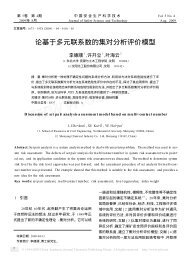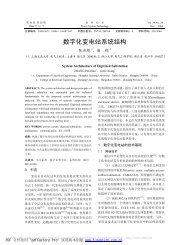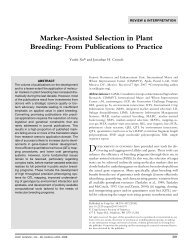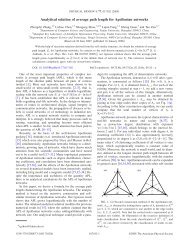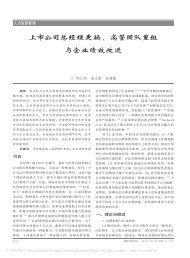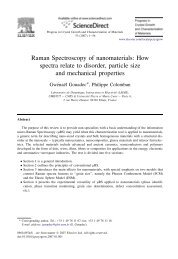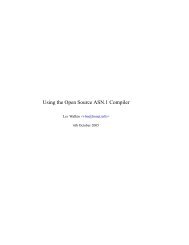Scanning Near-Field Optical Microscopy and Spectroscopy as a ...
Scanning Near-Field Optical Microscopy and Spectroscopy as a ...
Scanning Near-Field Optical Microscopy and Spectroscopy as a ...
Create successful ePaper yourself
Turn your PDF publications into a flip-book with our unique Google optimized e-Paper software.
REVIEWSheat, which causes ablation from the locally heated spot. Aballistic mechanism is also possible, in which the materialfrom the tip is sputtered onto the sample <strong>and</strong> material ablatesfrom the surface. A ballistic mechanism is the most likelyexplanation for an experiment carried out on an anthracenesurface using a completely metallized SNOM tip, [41] since, inthis c<strong>as</strong>e, no photons reach the sample <strong>and</strong> therefore a sputterprocess, either by metal atoms from the tip or by materialadsorbed on its surface, w<strong>as</strong> believed to be the re<strong>as</strong>on for theablation process. Fourth, one also h<strong>as</strong> to take transientthermal expansion [71±73] into account <strong>as</strong> a possible mechanismfor the creation of surface indentations, but it is likely to benegligible. [70]We now discuss an experiment that gave clear results aboutthe ablation mechanism of a rhodamine B film. The samplew<strong>as</strong> irradiated with l<strong>as</strong>er pulses either at its optical adsorbtionmaximum (ªon resonanceº, 532 nm) or nearby this point (ªoffresonanceº, 650 nm).SNOM tips with aperturesof < 100 nm diameterwere used. No significantdifference inthe optical transmissionof the SNOM tip overthe 400 to 650 nmrange, although somedecre<strong>as</strong>e is expectedwith an incre<strong>as</strong>ing differencebetween thewavelength <strong>and</strong> tipaperture size. Figure 11shows shear-force topographicimages recordedafter several l<strong>as</strong>erpulses had been firedonto the sample. Noablation w<strong>as</strong> observedfor the off-resonanceFigure 11. Shear-force topographic imagesof a rhodamine B film after trans-11 A; l ˆ 650 nm,wavelength (Figuremitting l<strong>as</strong>er pulses through the SNOM 2.1 mJ per pulse). Intip at A) 2.1 mJ atl ˆ 650 nm, far fromcontr<strong>as</strong>t, well defined,the maximum absorption of rhodamineB, <strong>and</strong> B) 1.4 mJ atl ˆ 532 nm (B), a 70 nm diameterwavelength near the maximum absorption.The total topographic contr<strong>as</strong>t in holes were created(FWHM), 5 nm deepthe z direction is A) 10 nm <strong>and</strong>when the l<strong>as</strong>er operatedB) 30 nm.at a wavelength that isstrongly absorbed bythe sample (Figure 11 B; l ˆ 532 nm, 1.4 mJ per pulse). Thisclearly points to an optical ablation mechanism, eitherphotochemical or photothermal. Energy transfer by absorptionof photons appears to be more efficient than by a ballisticprocess. The photon energy used here is not sufficient forinducing bond dissociation in rhodamine molecules, in contr<strong>as</strong>tto ablation experiments with ultraviolet l<strong>as</strong>er radiation,where photochemical dissociation is often used to rationalizethe observed phenomena. [74] We therefore suggest that aphotothermal mechanism is responsible for the ablation of therhodamine film: The absorbed photon energy is converted toR. Zenobi <strong>and</strong> V. Deckertvibrational excitation, which causes a rapid temperatureincre<strong>as</strong>e <strong>and</strong> leads to thermal desorption of the molecules.Another interesting observation in Figure 11 is that theablated material is redeposited on the sample surface close tothe ablation crater. The distribution of redeposited materialw<strong>as</strong> not symmetric in this experiment but w<strong>as</strong> always to theleft side of the crater <strong>and</strong> independent of the scan direction. Inother SNOM ablation experiments, the distribution w<strong>as</strong> moresymmetric. The origin of the directionality appears to be thetip itself: The apex of a SNOM tip is frequently not symmetric<strong>and</strong> the ablated material is ejected in a specific direction.Transport over micrometer distances w<strong>as</strong> observed inseveral c<strong>as</strong>es. The result of such an experiment is shown inFigure 12. [70] Here, an anthracene crystal surface w<strong>as</strong> continuouslyirradiated with a pulsing l<strong>as</strong>er (6 ns, 532 nm, 50 mJ)operated at a 20 Hz repetition rate over a 1 2 mm area. Ashear-force image of a larger area w<strong>as</strong> then recorded withoutFigure 12. Transport of material over many micrometers: A topographicimage of a 5 8 mm area of an anthracene film crystal surface, previouslyirradiated in a 1 2 mm trench in the upper left corner with ablating l<strong>as</strong>erpulses (pulse: 6 ns pulse; wavelength: 532 nm; pulse energy: 50 mJ;repetition rate: 20 Hz). Total topographic contr<strong>as</strong>t in the z direction is100 nm. Adapted from ref. [70].irradiation. An approximately 1 mm wide trench with welldefined edges could be detected in the upper-left corner of theimage, while a 2 mm wide, 60 nm high mound w<strong>as</strong> found about5 mm away running roughly parallel to the trench. Weinterpret this again <strong>as</strong> vaporization followed by redepositionof material in a preferred direction. The direction ofdeposition is most likely determined by an <strong>as</strong>ymmetry of thetip. For collection of ablated molecules, for example by avacuum interface to a m<strong>as</strong>s spectrometer, this <strong>as</strong>ymmetrycould be an advantage if the SNOM tip could be arranged todirect the ablated material towards the collector.From Figure 12 we also estimate that only a few, largerchunks of material are ablated. Most of the anthracene isfound in the form of a diffuse <strong>and</strong> structureless mound, whichis expected if the molecules are redeposited from the g<strong>as</strong>ph<strong>as</strong>e. We have also shown that the l<strong>as</strong>er-ablated moleculesdo not decompose. [70] We conclude that material transportdoes not take place by a mechanical dragging from the SNOMtip, but instead by vaporization <strong>and</strong> redeposition in a directiondictated by the <strong>as</strong>symetry of the tip.4. Conclusions <strong>and</strong> Outlook<strong>Near</strong>-field imaging b<strong>as</strong>ed on aperture probes can nowprovide spectroscopic data with a lateral resolution on the1754 Angew. Chem. Int. Ed. 2000, 39, 1746 ± 1756





